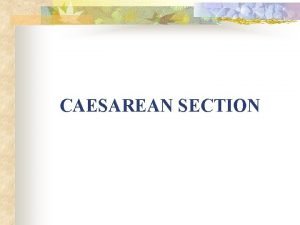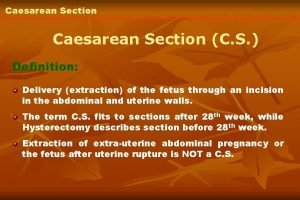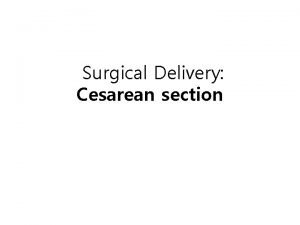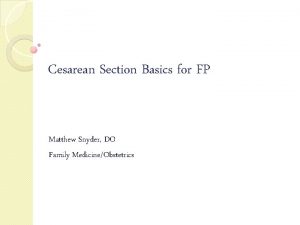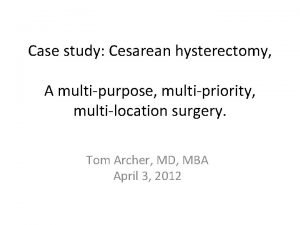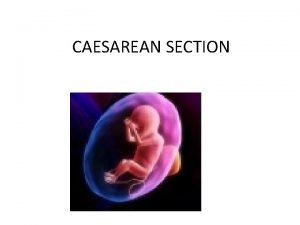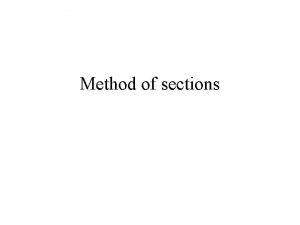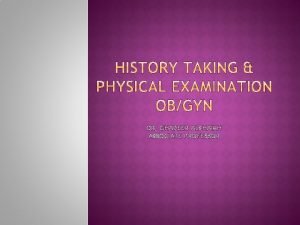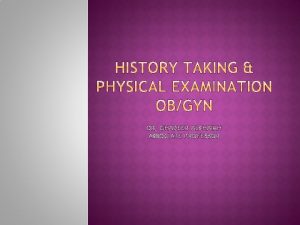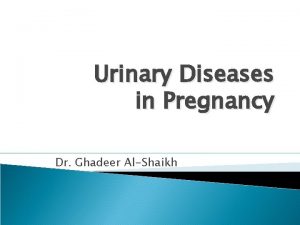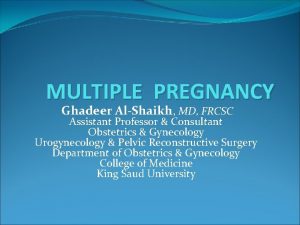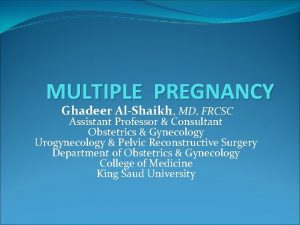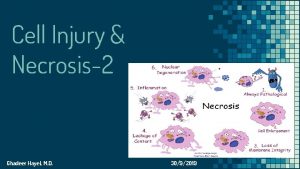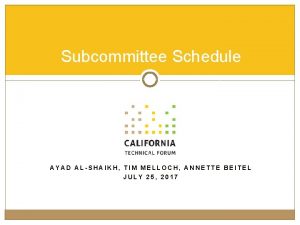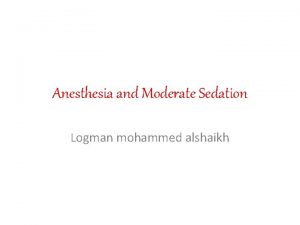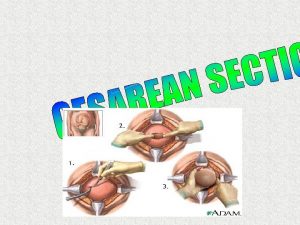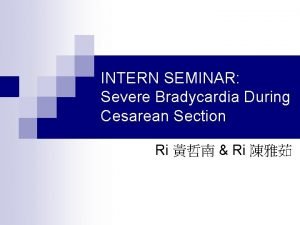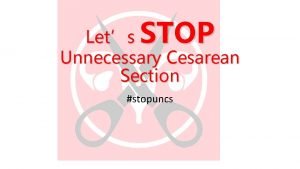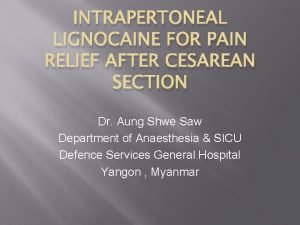CESAREAN SECTION CS CESAREAN SECTION Cs Ghadeer AlShaikh




















- Slides: 20

CESAREAN SECTION CS

CESAREAN SECTION Cs Ghadeer Al-Shaikh, MD, FRCSC Assistant Professor & Consultant Obstetrics & Gynecology Urogynecology & Pelvic Reconstructive Surgery

TYPES OF CS n n Lower segment CS Classical CS

Indications for classical CS n n n Transverse lie back down (with SROM) Structural abnormality that makes lower segment approach difficult (Fibroids) Anterior Placenta Previa & abnormally vascular lower segment Poorly developed lower segment in Very preterm fetus in breech presentation Cervical cancer

INDICATIONS FOR ELECTIVE CS n n n Repeat CS Placenta previa VV fistula repair HIV (poor controlled) Active herpes Fetal macrosomia > 4500 gm n n n Uterine surgery eg. Hystrotomy, myomectomy Severe IUGR Breech Multiple pregnancy Transverse lie Ca of the Cx/ TR obstructing the birth canal

INDICATIONS FOR EMERGRENCY CS n n n n n Severe PET Abruptio placenta (APH) Fetal distress Failure to progress in the first stage of labour Cord prolapse Obstructed labour Failed induction Malpresentation brow, chin post, shoulder & compound presentations, breech Compromised fetus 2 ry to DM, HPT, isoimmunization

TIMING OF ELECTIVE CS n Usually at 38 -39 wks

Before Emergency CS n Explain to the Pt & husband & obtain consent n Inform anesthetist, OR staff, ped n 100% oxygen mask in case of fetal distress n Sodium citrate 20 ml , metoclopramide 10 mg IV n Transfer to theatre, IV , take blood for Hb, xmatch 2 U of blood Preferable to use spinal or epidural anaethesia n

n n n Catheterize the bladder Tilt the mother 15 º by using wedge Pneumatic inflatable boots or Ted stockings Prophylactic Ab ↓↓ incidence of infection Inform ped if the mother had opiates in the last 4 hrs Halothane should not be used uterine relaxation & bleeding

COMPLICATIONS INTRAOPERATIVE n Bleeding & the need for bl transfusion n Hysterectomy n Complications of anaesthesia n Damage to the bladder, ureter, colon , retained placental tissue n Fetal injury

COMPLICATIONS POSTOPERATIVE n Paralytic ileus n Wound dehiscence & infection n Infectins UTI, pnemonea n DVT & pulmonary embolism n Fistula n Death

POSTNATAL CARE n n n V/S & blood loss must be monitered Uterine fundus palpated Effective parentral analgesics Deep breathing & coughing encouraged Early mobilization Fluid therapy &diet Bladder & bowel function Wound care Lab Breast care Prophylaxis for thrombembolism

MODE OF DELIVERY IN NEXT PREGNANCY CRITERIA FOR VBAC n Pt must agree to the procedure n A low transverse uterine incision n Non recurrent cause of the previous CS n No macrosomia, malposition, multiple gestation, breech

MODE OF DELIVERY IN NEXT PREGNANCY Contraindication n Previous classical CS n 2 or more previous CS n Previous other uterine surgery n Hx of scar rupture n Placentaprevia or transverse lie

CONDUCT OF LABOUR Observe for n Progress n Fetal wellbeing n Maternal well being n Epidural n HOSPITAL SHOULD PROVIDE BLOOD , OPERATING ROOM 24 HRS, NEONATAL RESUSCITATION, NURSING ANAESTHESIA &SURGICAL PERSONNEL CAN START CS WITHIN 30 MIN

Risk of SCAR RUPTURE n n O. 5% for LSCS 4 -9% for classical

SCAR RUPTURE Signs OF SCAR RUPTURE n Fetal distress n Ease of fetal palpation n Cessation of contractions n Elevation of presenting part n Scar pain n Bleeding / shock

ABNORMAL LABOUR/DYSTOCIA/FAILURE TO PROGRESS IN LABOUR CAUSES 1 -Abnormalities of the pasage n n Alteration in the shape of the pelvis Mass occupying the birth canal

ABNORMAL LABOUR/DYSTOCIA/FAILURE TO PROGRESS IN LABOUR 2 -Abnormalities in the passenger n Abnormal lie n Abnormal presentation occiput-postrior, occiput-transverse brow face breech n Macrosomia , perinatal mortality 5* higher than N Wt n Congenital malformation n Multiple gestation

ABNORMAL LABOUR/DYSTOCIA/FAILURE TO PROGRESS IN LABOUR 3 -Abnormalities in the powers n Ineffective uterine activity n Lack of voluntary expulsive efforts in the 2 nd stage DYSTOCIA IS THE MOST COMMON INDICATION FOR CS
 Ghadeer khum
Ghadeer khum Contraindications of cesarean section ppt
Contraindications of cesarean section ppt Complications c section
Complications c section C section type
C section type Forceps delivery ppt
Forceps delivery ppt Cesarean instruments list with pictures
Cesarean instruments list with pictures Fetus and newborn affected by cesarean adalah
Fetus and newborn affected by cesarean adalah Baseball stitch classical cesarean
Baseball stitch classical cesarean Cesarean hysterectomy steps
Cesarean hysterectomy steps Cesarean julius caesar
Cesarean julius caesar Chemical potential energy images
Chemical potential energy images Half section view example
Half section view example Concept mapping chapter 10 meiosis 1 and meiosis 2
Concept mapping chapter 10 meiosis 1 and meiosis 2 Revolved sectional view
Revolved sectional view What is full section?
What is full section? Section 15-1 the puzzle of life's diversity answer key
Section 15-1 the puzzle of life's diversity answer key Spe gulf coast section
Spe gulf coast section Method of sections
Method of sections Chapter 7 section 1 inside the earth answer key
Chapter 7 section 1 inside the earth answer key 35-1 human body systems
35-1 human body systems A global conflict chapter 13 section 3
A global conflict chapter 13 section 3

